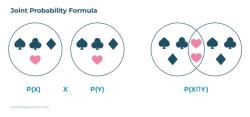How do you convert point slope into standard form?
Converting a linear equation from point-slope form to standard form involves rearranging the equation to express it in the form Ax + By = C, where A, B, and C are integers, and A is non-negative. Here's a step-by-step guide to help you do this:
Point-Slope Form: The point-slope form of a linear equation is given as:
y - y₁ = m(x - x₁)
where (x₁, y₁) is a point on the line, and m is the slope of the line.
Standard Form: The standard form of a linear equation is:
Ax + By = C
Here are the steps to convert from point-slope form to standard form:
Start with the point-slope form equation:
y - y₁ = m(x - x₁)
Distribute the slope 'm' on the right side of the equation:
y - y₁ = mx - mx₁
Add y₁ to both sides of the equation to isolate 'y':
y - y₁ + y₁ = mx - mx₁ + y₁
This simplifies to:
y = mx + (y₁ - mx₁)
Now, you have 'y' expressed in terms of 'x' and constants. To convert to standard form, move all terms to one side of the equation, so the equation looks like Ax + By = C. To do this, subtract 'mx' from both sides:
y - mx = y₁ - mx₁
Rearrange the terms and write 'mx' as 'mx' and 'y₁ - mx₁' as 'C':
-mx + y = y₁ - mx₁
To make the coefficient of 'x' positive, multiply both sides of the equation by -1:
mx - y = mx₁ - y₁
Now, you have the equation in standard form:
mx - y = mx₁ - y₁
Note that 'm' represents the slope of the line, 'x' and 'y' are variables, and 'mx₁ - y₁' is a constant 'C.'
This is the standard form of the linear equation obtained from the given point-slope form equation. The coefficients 'A' and 'B' are integers, and 'A' is non-negative as required for standard form.
To convert point-slope form to standard form, follow these steps:
- Distribute the slope in the point-slope form equation.
- Move the x-term to the same side of the equation as the y-term.
- Combine the constant terms on the right side of the equation.
- Write the equation in standard form (Ax + By = C).
Here is an example:
Point-slope form:
y - 2 = 3(x - 1)
Step 1: Distribute the slope in the point-slope form equation.
y - 2 = 3x - 3
Step 2: Move the x-term to the same side of the equation as the y-term.
y = 3x - 3 + 2
Step 3: Combine the constant terms on the right side of the equation.
y = 3x - 1
Step 4: Write the equation in standard form (Ax + By = C).
3x - y = 1
Therefore, the equation in standard form is:
3x - y = 1
Here are some additional tips for converting point-slope to standard form:
- If the slope is negative, be sure to distribute the negative sign.
- If the constant term in the point-slope form equation is negative, be sure to add the opposite of that number to the other side of the equation when you move the x-term.
- Once you have the equation in standard form, check your work by making sure that the coefficients of the x and y terms are both non-negative.












